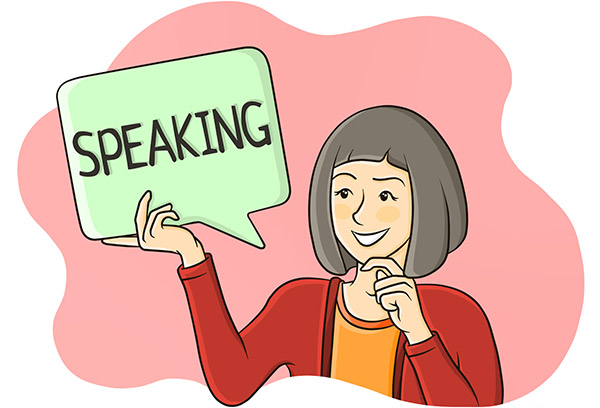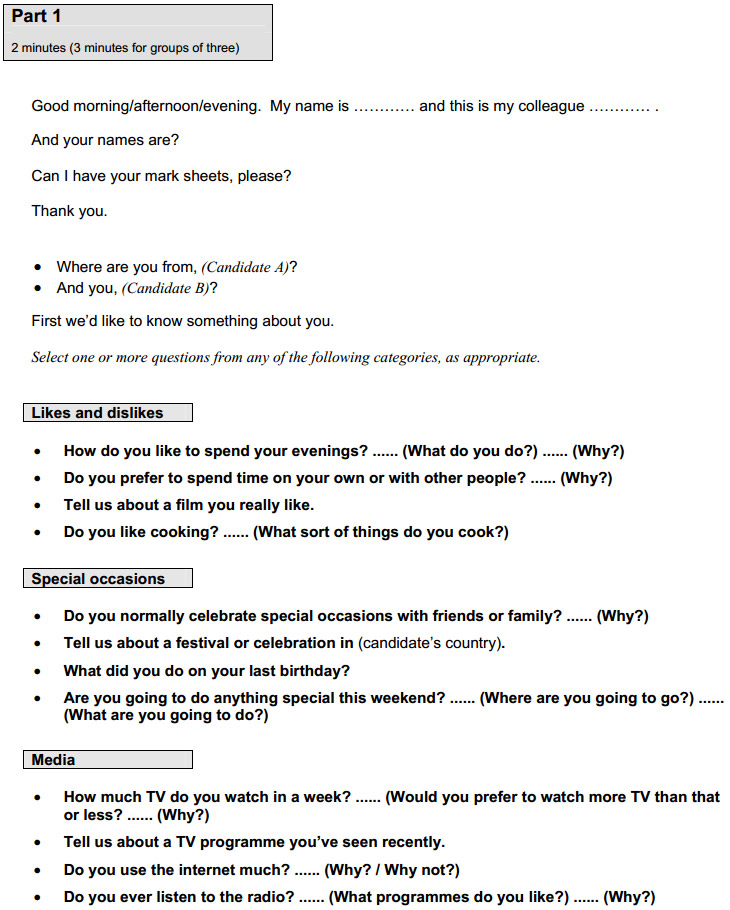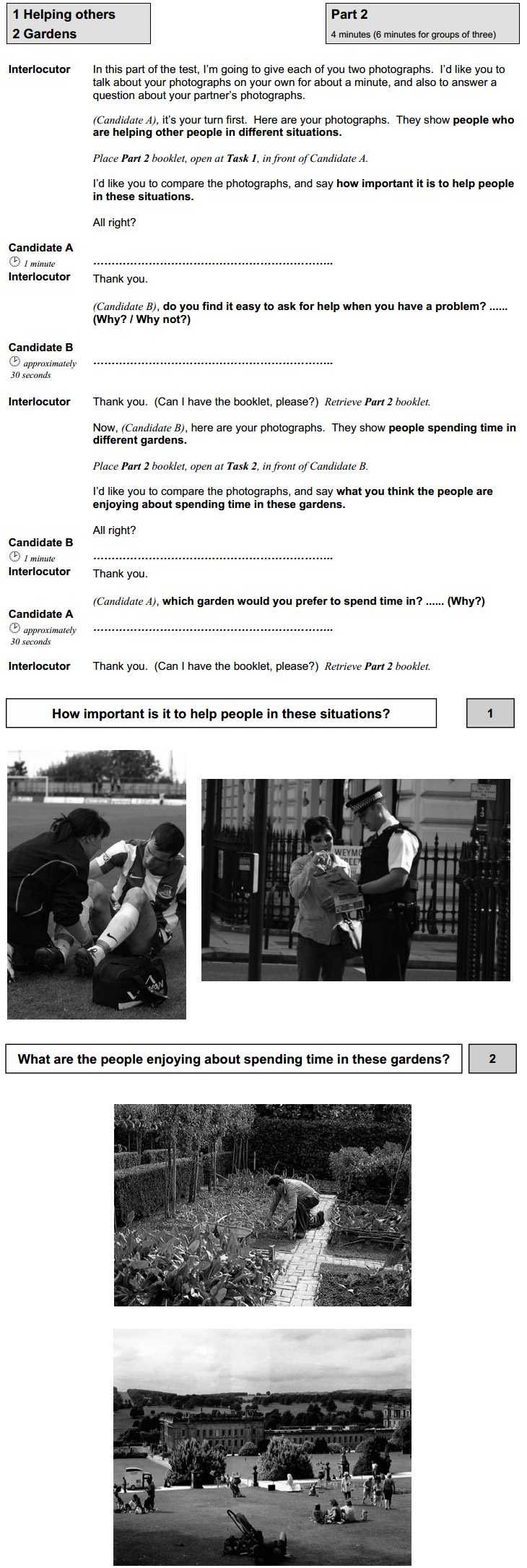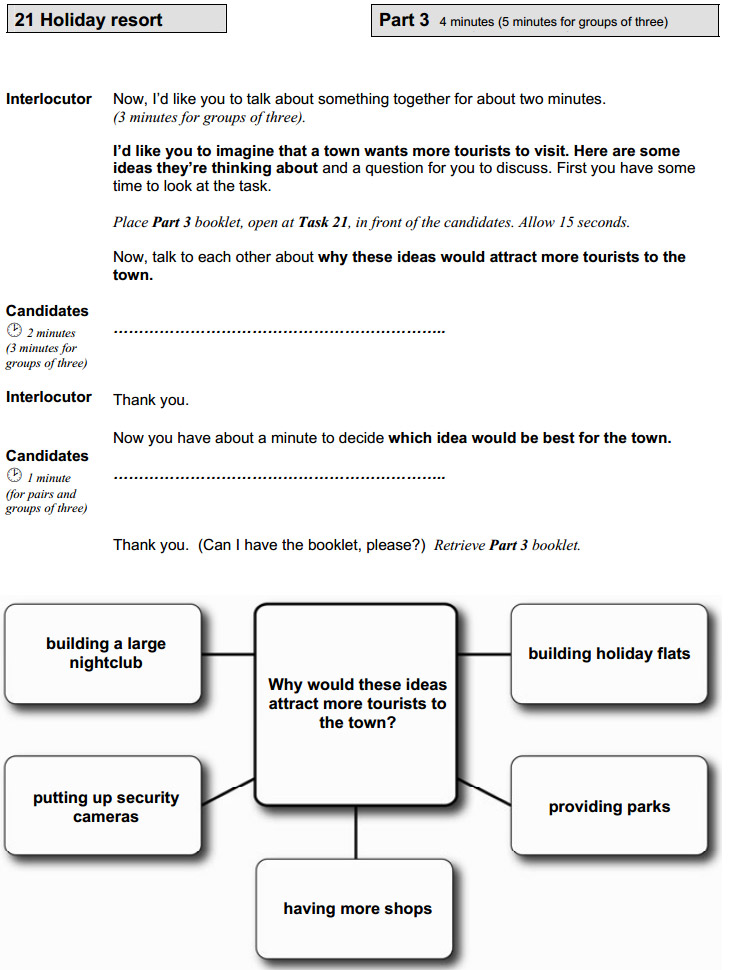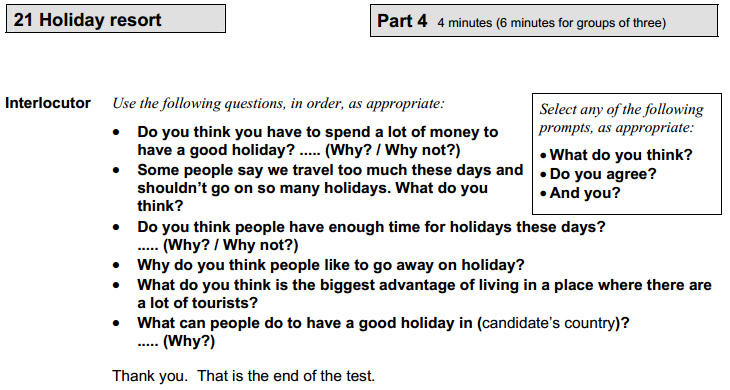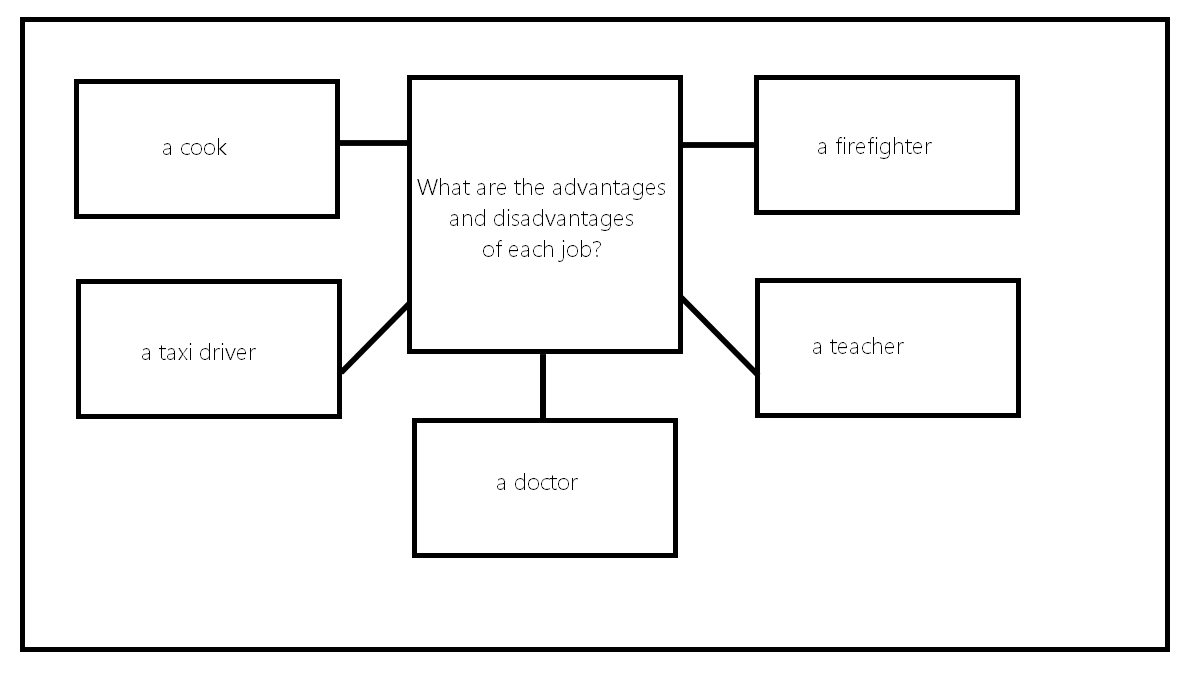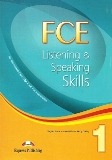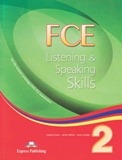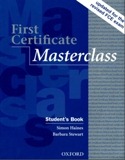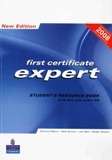FCE Speaking (говорение) — это заключительная часть международного экзамена Cambridge English: First, подтверждающего ваше владение английским языком на уровне Upper-Intermediate (выше среднего). В разделе FCE Speaking необходимо показать, что вы действительно соответствуете этому уровню и можете достаточно свободно общаться на английском языке. В этой статье мы расскажем, как подготовиться к FCE Speaking, чтобы сдать эту часть экзамена на высший балл.
Содержание:
- 1. FCE Speaking Part 1. Interview
- 2. FCE Speaking Part 2. Long turn
- 3. FCE Speaking Part 3. Collaborative task
- 4. FCE Speaking Part 4. Discussion
- 5. Общие советы о том, как отвечать на FCE Speaking
Формат экзамена FCE в 2015 году претерпел некоторые изменения. Они несильно коснулись раздела Speaking. Структура и общее время прохождения остались прежними: 14 минут на 4 части. Изменилось распределение времени на каждое задание, и в третьей части задание представлено не в виде картинок, а в виде текста. FCE Speaking состоит из следующих частей:
- Part 1. Interview — 2 минуты.
- Part 2. Long turn — 3 минуты.
- Part 3. Collaborative task — 5 минут.
- Part 4. Discussion — 4 минуты.
В разделе FCE Speaking проверяется беглость речи, словарный запас, знание грамматики, произношение (именно произношение, а не акцент). Особенность этой части экзамена заключается в том, что вы сдаете ее не самостоятельно, а с другим кандидатом, в редких случаях — с двумя. Задания проверяют 2 экзаменатора. Один экзаменатор задает вопросы и предлагает темы для обсуждения, второй — оценивает ваши умения и делает пометки относительно вашего ответа. Во время теста вы общаетесь и с экзаменатором, и с другим кандидатом.
FCE Speaking Part 1. Interview
Interview — это своего рода знакомство, на которое отводится по одной минуте для каждого кандидата. В этой части вы беседуете только с экзаменатором. Круг тем в interview довольно стандартный: ваша семья, родной город, интересы, учеба, работа, свободное время, планы на будущее. В большинстве случаев экзаменатор выбирает одну тему и задает по ней 3-4 вопроса. Ознакомьтесь с примерами вопросов, которые могут встретиться на экзамене:
Are you working or studying at the moment? Where?
What sort of job would you like to do in the future?
How do you like to spend your evenings? What do you usually do? Why?
Is your town large or small / clean or polluted / quiet or noisy?
Are you going to do anything special this weekend? Where are you going to go?
Do you use the Internet much? Why? Why not?
Что проверяется: умение рассказать о себе и ответить на вопросы общего характера.
Как готовиться
Потренируйтесь давать краткие, но емкие ответы на типичные вопросы. Давайте рассмотрим на примере, что значит «краткий, но емкий ответ».
В задании interview есть вступительная часть, которая называется warm up (разогрев). Эта часть обычно состоит из двух вопросов: What is your name? (Как вас зовут?) и Where are you from? (Откуда вы?).
Отвечая на вопрос Where are you from?, вы можете сказать не только название города, но и добавить какую-то его особенность:
- Большой город или маленький: It is a small provincial town / big city / megalopolis.
- Где он находится: It is situated in the North/South/East/West of the country.
- Чем он примечателен: It is a cultural capital / a capital of fashion / an industrial city.
Вы можете указать любую другую особенность вашего города. Увлекаться подробностями тоже не стоит, 1-2 фактов будет достаточно.
Как отвечать
- Не впадайте в крайности. Не следует отвечать одним словом Yes/No или элементарными предложениями, такими как I like it / I agree with you. В то же время не стоит давать длинные, пространные ответы и вдаваться в подробности.
- Отвечайте на вопрос прямо. Если вас спросили о планах на будущее, не надо рассказывать, где вы работаете сейчас и почему хотите поменять работу. Такая формулировка не даст ответ на конкретно поставленный вопрос — ваши планы на будущее. Скажите, что в ваших планах поменять работу, потому что, возможно, вы нашли что-то более интересное или планируете переехать за границу.
- Старайтесь звучать естественно. Ваша речь должна быть достаточно беглой. Если вы забыли какое-то слово, скажите другое. Не тратьте время на то, чтобы вспомнить нужное слово, это выглядит крайне неестественно.
Пример задания:
Пример задания interview на экзамене FCE
FCE Speaking Part 2. Long turn
В этом задании вы получаете буклет с двумя фотографиями, на которых, как правило, изображены люди. Вверху страницы, над фотографиями, стоит вопрос, на который вам надо ответить. Экзаменатор попросит вас в течение одной минуты ответить на вопрос, описать и сравнить фотографии, сказать, что вы думаете об этих снимках, нравятся они вам или нет. Времени на подготовку не дается, вы начинаете говорить сразу и говорите в этой части только с экзаменатором. После вашего рассуждения экзаменатор задает второму кандидату вопрос о ваших картинках. Второй участник должен отвечать в течение 30 секунд. Затем вы меняетесь ролями: второй кандидат получает другие фотографии и отвечает в течение минуты, а после его рассказа экзаменатор спрашивает, что думаете вы о картинках собеседника. На ответ вам дается 30 секунд.
Что проверяется: монологическая речь — умение описывать, сравнивать, рассуждать, представлять свое мнение.
Как готовиться
- Тренируйтесь описывать и сравнивать картинки. Для этого надо работать с как можно большим числом картинок.
- Тренируйтесь выражать свою точку зрения. Запаситесь красивыми фразами, которые вам в этом помогут. Например: As far as I’m concerned… (Я убежден в том, что…), I tend to think that… (Я склонен думать, что…). Не ограничивайте себя банальными I think / I like / I don’t like.
- Засекайте время на ответ. В этой части вам дается всего 1 минута, за которую вы должны успеть описать, сравнить и высказать свое мнение.
Как отвечать
- Начните свою речь с общего описания: кто изображен, что он делает. Обязательно обозначьте тему картинок.
- Не забывайте сравнивать изображения. Если вы сначала расскажете все об одной фотографии, а затем о другой, то элемент сравнения потеряется. Для сравнения используйте фразы:
- These two pictures show people who… — На этих фотографиях мы видим людей, которые…
- In the first picture … is depicted, and in the second picture we can see… — На первой картинке изображен …, а на второй картинке мы видим…
Довольно большой список таких выражений мы собрали в статье «Фразы для сравнения и противопоставления».
- Не растекайтесь мыслью по древу. Помните, что на ответ у вас есть всего 1 минута.
Пример задания:
Пример задания long turn на экзамене FCE
FCE Speaking Part 3. Collaborative task
В части collaborative task вам снова придется выражать свое мнение, только на этот раз уже в форме беседы с другим кандидатом. Экзаменатор предлагает вам тему для обсуждения и несколько идей, которые вы должны осветить в своем диалоге. Ваша задача — обсудить выбранную тему и прийти в итоге к согласию с другим кандидатом. На обсуждение вы получаете 2 минуты, после чего экзаменатор останавливает вас и просит прийти к общему выводу, на это дается еще одна минута.
Что проверяется: диалогическая речь и ваше умение общаться с людьми — обмениваться мыслями, обосновывать и подтверждать свое мнение, оценивать чужое мнение, соглашаться или не соглашаться с собеседником.
Как готовиться
- Самый лучший вариант подготовки — создать условия, максимально приближенные к условиям экзамена. Поэтому тренируйтесь обсуждать разные ситуации с кем-нибудь, кто хорошо знает английский. Если такой возможности нет, придется выкручиваться и рассуждать самостоятельно. Чтобы ваш ответ не превратился в монолог, засекайте время. Вы должны говорить примерно половину отведенного на задание времени.
- Темы на экзамене могут встретиться самые разные, но слова и выражения общего плана, которые помогут вам высказать свое мнение, согласиться или не согласиться с собеседником, понадобятся обязательно. Вы можете найти такие выражения на сайтах vocabulary.cl и learnenglishteens.britishcouncil.org.
Как отвечать
- Начните с какой-нибудь вступительной фразы: Let’s begin with… (Давайте начнем с…); Why don’t we start by discussing… (Почему бы нам не начать с обсуждения…); We could start by talking about… (Мы могли бы начать говорить о…).
- Сначала обсудите плюсы и минусы каждой идеи, после переходите к заключению. Очень важно прийти к общему мнению в заключении. То есть, обсудив все варианты, вы должны остановиться на каком-то одном, который, по вашему мнению и мнению второго кандидата, отвечает на главный вопрос.
- Слушайте второго кандидата и взаимодействуйте с ним. Ваш ответ должен выглядеть полноценным диалогом, а не двумя отдельными монологами на общую тему.
- Старайтесь говорить 50 на 50. Если вам попался молчаливый собеседник, задавайте ему наводящие вопросы: What do you think of it? (Что ты об этом думаешь?); What is your opinion on the issue? (Каково твое мнение по этому вопросу?); I think… What about you? (Я думаю… А ты что думаешь?). Если ваш собеседник слишком разговорчивый, не перебивайте его резко, постарайтесь вежливо вступить в диалог. В этом вам помогут фразы из статьи «Как мастерски прервать собеседника? Dealing with interruptions»
- Взаимодействуйте не с экзаменатором, а со вторым кандидатом, иначе ваш ответ будет выглядеть как проверка домашнего задания на уроке английского языка. Вы должны вести себя естественно, чтобы экзаменатор видел, что вы уверены в своих знаниях и владеете английским языком на данном уровне.
Пример задания:
Пример задания collaborative task на экзамене FCE
FCE Speaking Part 4. Discussion
Discussion — заключительная часть, в которой вы общаетесь и с экзаменатором, и с другим кандидатом. Discussion — это продолжение collaborative task. Здесь вы продолжаете обсуждать тему, которая была в предыдущем задании. Всего на четвертую часть дается 4 минуты. Сначала экзаменатор задает вам и второму кандидату по два вопроса, на которые вы по очереди отвечаете, затем он просит вас обсудить какой-то вопрос вместе.
Что проверяется: умение вести дискуссию на заданную тему. Здесь вы должны показать, что можете рассуждать на предложенную тему, подтверждать свои слова, приводить доводы.
Как готовиться
- Как и в части collaborative task, потренируйтесь вести диалог с кем-нибудь на английском языке.
- Если такой возможности нет, засекайте время, которое вы тратите на ответ. Всего экзаменатор задает 5-6 вопросов. Следовательно, ответ на каждый вопрос должен занимать 20-30 секунд. При этом качество ответа не должно страдать: вы должны использовать слова и грамматические конструкции, соответствующие уровню Upper-Intermediate.
- Тренируйтесь отвечать кратко. В этой части экзаменатор задает вопросы, которые в основном начинаются со слов: What do you think… / What is your opinion… / What can you tell about… ? — Что вы думаете о… ? То есть вам необходимо представить свою точку зрения. Но времени дается немного.
- Для того чтобы не тратить много времени, придумывая, как перейти к следующей мысли, и не использовать много лишних слов, учите linking words (слова-связки). С их помощью вы сможете логично и последовательно дополнить мысль, противопоставить одну идею другой, подвести итог всему вышесказанному. Найти эти слова можно здесь: dlsweb.rmit.edu.au.
Как отвечать
- Начинайте говорить со вторым кандидатом, когда экзаменатор вам это предложит. Не следует вовлекать в разговор второго кандидата, если вопрос адресован только вам. Когда вопрос будет задан обоим участникам, экзаменатор обязательно даст вам это понять.
- Смотрите на того, с кем разговариваете. Если экзаменатор обращается к вам, установите зрительный контакт с ним. Если экзаменатор задает вопрос обоим участникам экзамена, значит, надо повернуться ко второму кандидату и начать с ним разговор.
- Не забывайте использовать linking words и выражения, которые помогут вам сформулировать мнение.
Пример задания:
Пример задания discussion на экзамене FCE
Общие советы о том, как отвечать на FCE Speaking
1. Не молчите
Если вы не поняли вопрос или вам нужно пару секунд подумать над ответом, скажите об этом. Вежливо переспросить вам помогут фразы:
- Sorry, I didn’t hear what you said. Could you repeat the question, please? — Извините, я не расслышал, что Вы сказали. Не могли бы Вы повторить вопрос, пожалуйста?
- Sorry, I didn’t catch what you said. — Извините, я не понял, что Вы сказали.
- I’m sorry. Could you repeat the question again, please? — Извините, не могли бы Вы повторить еще раз?
Если вам нужно пару секунд на размышления, используйте выражения:
- That’s a hard question. Can I have a second to think about it. — Это сложный вопрос. Могу я подумать пару секунд?
- Well, let me think. — Надо подумать.
- That’s a good idea/question. — Хорошая мысль/вопрос.
- It’s difficult to say. But I suppose that… — Сложно сказать. Но я предполагаю, что…
2. Приукрасьте действительность
Вам никто не запрещает придумывать ответы, даже если на самом деле вы думаете по-другому. Никто не будет проверять, сказали вы правду или нет. Экзаменатор оценивает форму ответа, то есть насколько грамотно вы говорите, используете ли грамматику и лексику уровня FCE. А содержание ответа его интересует мало.
3. Практикуйтесь как можно больше
Многие полагают, что к устному вопросу трудно подготовить ответ заранее, ведь речь должна быть спонтанной. Тем не менее ко всем типичным вопросам можно подготовиться. Учите наизусть фразы, грамматические конструкции в контексте, а потом старайтесь вставить их в свой ответ. Успешная сдача экзамена — это 10% удачи и 90% подготовки. И под подготовкой подразумевается все, что вы делаете в отношении английского. Смотрите сериал на английском — развиваете навык восприятия речи и уменьшаете вероятность не понять, что говорит вам собеседник. Читаете книги на английском — машинально запоминаете фразы в контексте и как их употреблять. Пишете сочинение — зазубриваете правильные конструкции. Запомните — все имеет значение!
Посмотрите пример FCE Speaking с комментариями экзаменаторов. Комментарии от экзаменаторов доступны в этом документе.
Практиковать разговорную речь самостоятельно нелегко. Намного легче, когда есть собеседник. А если вы хотите получить за раздел FCE Speaking высший балл, то собеседник должен быть грамотным. Среди преподавателей нашей школы вы сможете найти такого грамотного собеседника. На курсе «Подготовка к экзамену FCE», он поможет вам не только разговориться, но и научит вас выражать свои мысли красивыми словами и правильными конструкциями.
© 2023 englex.ru, копирование материалов возможно только при указании прямой активной ссылки на первоисточник.
FCE Speaking is the last part of your Cambridge English: First exam. It has 4 parts that last for about 14 minutes. There are usually two or three test-taker like you because some of the tasks involve interaction between candidates. There will be two examiners present – one asking the questions (the interlocutor), and the other assessing responses (the assessor). This page has an overview of the exam structure, sample questions and answers, tips on how to get better score and how your answer is assessed. You can use the contents list below to navigate between parts or just read the whole thing (highly recommended if you are new to the exam).
1. Part 1 – Interlocutor and candidate conversation (2 minutes)
— 1.1 Part 1 sample questions with answers
2. Part 2 – Describing photos. Long and short turns (3 minutes)
— 2.1 Part 2 sample photos with answers
— 2.2 Part 2 tips and useful phrases
3. Part 3 – Discussion between candidates and reaching an agreement (discussing a mind-map) (3 minutes)
— 3.1 Part 3 sample mind-map with answers
4. Part 4 – Discussing and developing topic from Part 3 (4 minutes)
— 4.1 Part 4 sample questions with answers.
5. FCE Speaking marking criteria
FCE Speaking Part 1 – Interlocutor and candidate conversation
Quick Summary
- Part 1 lasts for about 2 minutes for each candidate
- Test-taker and examiner interaction, no interaction between test-takers
- Questions about familiar everyday topics
- Two to four questions, answers should be kept short (around two sentences)
Part 1 of FCE Speaking focuses on your ability to talk about topics of general interest, such as your work or studies, how you spend your free time or your plans for the future – something you are familiar with. In this part the interlocutor asks each candidate two or three questions. You are expected to listen what the other candidate says as well as the questions asked as you might be asked the same question (e.g. “And what about you?”). However, this part does not involve direct communication between candidates. This part is about two minutes long.
Your answers shouldn’t be longer than a couple of sentences. Make sure to stick to the topic at hand. Your answers should also sound natural – do not use any memorised responses as they are easy to spot and this can often lead to a lower mark. Rehearsed answers might also be not about the question asked as there is considerable variety in the questions, even though the range of topics is quite limited.
There are no helpful phrases or tricks for FCE Speaking, Part 1 as this part focuses on your general ability to talk about yourself. You might want to check entry on cohesion to better connect idea in your answer. Another useful thing is to know synonyms to words like very and other easily synonymised words and expressions.
If you want to feel more confident with Part 1 questions – find a partner to practice the sample questions. Take turns asking and answering them, write down any mistakes or recommendations for one another. Practice is the best way to improve your chances of scoring high.
Part 1 sample questions and answers
What is your hometown like?
My hometown is Viña del Mar, it’s in Chile, just north of Santiago. It’s a coastal town that is popular with tourists because of the beautiful gardens and the beaches.
What do you do in your free time?
Uhm, I can’t say I have any particular hobbies to talk about, I guess I’m into oil painting. I enjoy painting landscapes in my free time because our city has such pretty views, they really inspire me!
How do you celebrate special occasions?
I’m not too outgoing so I either go for a walk in the city and treat myself to some food or just stay at home and listen to the music. If it’s something big, I might invite a couple of friends over, but’s that’s kind of a rare thing to do for me.
Do you have any plans for this summer?
Oh, definitely! The plan is to go to an art school in California, provided that I have successfully passed this exam. Another option is to study art in Santiago, that would be okay for me as well.
FCE Speaking Part 2 – Describing photos
Quick Summary
- Part 2 is 1 minute 30 seconds for each candidate
- Test-taker and examiner interaction, using another test-taker’s pictures for the second part of the answer
- Describing and comparing two pictures, answering a question related to them
- 60 seconds answer about your pictures (long turn), 30 seconds – additional questions about the other test-taker’s pictures (short turn)
In this part of FCE Speaking there are normally going to be two test-takers – Candidate A and Candidate B. Candidate A goes first, they get two pictures from the interlocutor and a question they have to answer. The question is written on the page with the two pictures. The questions can be about how people in the pictures might be feeling, what could be the advantages and disadvantages of the situation in each picture and so on – see more examples with answers here. After that Candidate A gets one minute to answer the question.
After this it’s turn of Candidate B to answer an additional question from the interlocutor. This additional question relates to the same set of pictures. It can be either about choosing one of the pictures, like “In which might the people feel more comfortable?” or a more general one relating to the situation, where you don’t have to choose a picture, for example “Is it better to study alone or with others?”. Candidate B has 30 seconds to answer the question.
After Candidate B has answered, they swap roles. This time Candidate B gets two pictures, a question from the examiner and one minute to answer it. After that Candidate A gets 30 seconds and one related question.
One important thing is that answering the question is only part of this task. You also have to describe both picture, speculate about them (see below) and compare them. Read on for detailed explanation of each aspect.
FCE Speaking Part 2 tips and useful phrases
FCE Speaking Part 2 is about three things:
1 – comparing (what is similar and what is different in the photos)
2 – describing (give brief description of what you see, usually description goes hand-in-hand with speculating)
3 – answering the questions
1. Comparing
Comparing is essential in Part 2 of FCE Speaking. You have to mention at least one thing that is common between the two photos and one that is similar. One if each should probably be enough as you only have 1 minute for your answer.
| Talking about similarities | Talking about differences |
|---|---|
| In both pictures there is… Both pictures display/show… Pictures one and two have… Pictures one and two are similar in the way that there is/are… in each one. Just like in the left picture , the right one has… These two pictures have several things in common, such as/like… |
Unlike the left picture, picture on the right has/shows/displays In contrast with the right picture, picture on the left is … Picture one…, while picture two… Picture two has a different idea of … if we compare it to the first photo While the second picture takes place in … Contrastingly, these pictures show different takes on *some topic* |
2. Describing
First thing to remember is to switch between various phrases that introduce picture description. Don’t reuse the same expression, switch between them, for example:
In the first photo, we can see/there is/ … is shown
The second picture shows/displays/demonstrates …
One big mistake that test-takers make is using the wrong tense. The only tense you should be using to describe pictures is Present Continuous! Failing this leads to lower mark – see official assessment report, page 3.
Another common mistake is spending too much time on describing. I’ve had student who would spend a whole minute on talking about what’s in the picture. Remember – do not spend more than 15-20 seconds on that. Another helpful technique is to include comparison in your description.
Finally, it is “in the picture”, not “on the picture” – a very shameful mistake to make!
“The first picture shows us a group of friends, having a good time. Contrastingly, in the second picture we see colleagues who are having a business lunch.”
The part in bold text shows comparison, underlined text is the usage of Present Continuous.
3. Answering the question
When you answer FCE Speaking Part 2 question ideally you would want to do so for both pictures at the same time. You should answer it together with comparing because otherwise you might not have enough time to do comparison separately. Have a look at the sample answers to get a better idea of including comparison in your answer.
Part 2 sample questions and answers
More FCE Speaking Part 2 sample questions with answers
FCE Speaking Part 2
Here are the photographs. They show people waiting for something.
I’d like you to compare the photographs, and say in which picture the waiting feels longer.
Sample answer
Candidate A: The left picture shows a man expecting his flight to arrive to the airport. In the picture on the right we see a couple of people waiting for their bus at a rather late hour. While both pictures convey the same idea, the people at the bus stop are probably much less comfortable as it is at night and it could be quite cold.
I guess that for the man at the airport gate the wait feels much longer. Air travel is a thrilling, even scary experience for most of us. The anxiety he might be experiencing could make the time go really slow for him. Also, flights can get late and generally you have to wait for quite some time before your plane is ready for boarding.
Examiner: Candidate B, how can one pass the time while waiting?
Candidate B: Well, there are many tried and true ways. In the past, people would read books or magazines, this was the most popular way of killing some time. Nowadays what almost everyone does is stare at their phone screen, either texting or looking at funny videos online.
Remember that you should use Present Continuous when describing pictures (i.e. “This picture shows people hurrying to their work in the early morning hours”). More on tenses in English.
Another tricky bit is the preposition. You should use “in” when talking about something shown by the picture (i.e. “In this picture we see a man strolling down the alley”). See this short note on prepositions for more examples.
FCE Speaking Part 3 – Mind map discussion between two candidates
Quick Summary
- Part 3 is about three minutes long
- Interaction between two test-takers, taking turns to express and justify their opinions
- A discussion topic with five aspects is represented as a mind map in the first part
- An agreement between test-takers on one of the aspects has to be reached in the second part
In Part 3 candidates receive a mind map which contains a questions and five prompts, or aspects, to be discussed. They have 15 seconds to study it and then have to decide who starts the discussion.
The candidates’ task is to discuss the topic using the given prompts. FCE Speaking Part 3 consists of two smaller parts. In the first part you should provide relevant responses on the topic, listen to and comment on the other candidate’s answers and transition from one idea to another in a logical way. This part lasts for about two minutes.
In the second part of this task you are given an additional question and have to choose one of the prompts and the answer providing reasoning and either agree or disagree on the chosen prompt. You get around one minute for this part.
Part 3 tips and useful phrases
There are three important aspects of FCE Speaking Part 3:
1 – Initiating the dialogue
2 – Going from one idea to another
3 – Coming to an agreement
1. Initiating the dialogue
When you start FCE Speaking Part 3 one of you has to start the conversation. The key here is to be polite and allow your partner choose, especially if they are shy or silent. You can either initiate this yourself of wait for your partner to go first:
| Starting the dialogue | Responding |
|---|---|
| Do you mind if I go first? Would you mind going first/starting? Care to go first? Should I begin, or would you like to go first? Would it be okay with you if I started this? Is it okay for you if I start? |
Yeah, sure, go ahead. Okay, I will! I’d rather you went first, if that’s okay with you. By all means, go ahead. Sure, not a problem |
A common rule is to allow whoever start first begin the conversation. Another thing that makes sense is to allow the other person initiate the dialogue in the second part.
2. Going from one idea to another
One thing that lowers your score in Part 3 is simply waiting for your turn to speak, not paying much attention to whatever the other student has to say. Such behaviour is penalised – in fact it is assessed in one of the marking criteria! A good approach is to include some points of your partner’s answer into your own. Another important thing is natural change from one idea (prompt) to another as you talk should be organic rather than a set of stand-alone sentences. Below are some ways to make your ideas better connected.
| Introducing an idea | Supporting or including an idea |
|---|---|
| What about… I believe that .. deserves mentioning/being mentioned If we’re talking about (topic), then… is definitely… I’m not sure that… is really important, however… A point worth discussing is… |
Speaking of… You’ve mentioned…, which is interesting because… I’d like to add another point regarding… There is one more thing about… Another aspect of… is that… |
3. Coming to an agreement
In the second half of FCE Speaking Part 3 your task is to choose one of the aspects (prompts) in connection with the given question and either agree or disagree whether it fits best. Agreeing is not mandatory, you are free to disagree, but do with respect to each other. Here are some useful phrases for suggesting, encouraging a conversation, agreeing and disagreeing:
| Agreeing | Disagreeing (politely) |
|---|---|
| I totally agree with your point… I’m with you on that one… Your arguments are very compelling I had a different idea, but your arguments sound very convincing Your points are very persuasive, and I side with you on that one |
I see what you mean, however… You make some valid points, but let’s consider… With all due respect, I can’t agree/I have to disagree Your logic here is flawless, but another point to consider is… |
| Suggesting ideas | Inviting to join |
|---|---|
| … is probably one of the things we should take/consider/mention, since… I think/believe that… is worth nominating/considering/mentioning/pointing out Let’s not forget about… Additionally,… should probably be included, as… |
Where do you stand on…? What’s your take on…? Please share your thoughts on this matter? What about your idea on? That’s what I think, but what about you? |
Part 3 sample task and answers
Here are some different types of occupation people might choose to have. First you have some time to look at the task. (15 seconds)
Now, talk to each other about the advantages and disadvantages of each of these occupations.
Sample answer
Candidate A (Juan): Should I go first?
Candidate B (Marian): Yes, please do.
Juan: I think that working as a chef at a restaurant or some other place is great. It is a creative occupation and you can express yourself through the dishes you make.
Marian: I get your points about expressing yourself and I totally agree. However, I guess with time it can get a bit repetitive – cooking day in, day out. Now working as a doctor is never the same, would you agree?
Juan: Yeah, I guess so. You face new challenges every day, it is a lot of responsibility, and the salary must be really high. You have to know a lot though. What about being a teacher, you have to be pretty knowledgeable too, right?
Marian: Yes, definitely. I don’t think teachers make as much money as doctors do, but the job itself might be even more rewarding!
Examiner: Thank you. Now you have about a minute to decide which profession would be more suitable for a younger person.
Marian: Oh, maybe a driver? You need a lot of energy to stay behind the wheel all day, and young people tend to be much more energetic than older ones. What would you say?
Juan: I was thinking about teaching as the best choice for young people, but I guess you have to have more experience to be good at this. So yeah, I’d go with your option of a taxi driver!
FCE Speaking Part 4 – Topic discussion
Quick Summary
- Part 4 is about four minutes
- Interaction between the examiner and two test-takers
- More abstract questions, answers are expected to be longer than in Part 1 (three sentences and more)
- The examiner invites the test-takers to discuss the questions together
Last part of FCE Speaking is similar to Part 1 – you are asked questions related to topic from Part 3 that you have to answer. However, there are three major differences in comparison with the first part. First of all, the questions are going to be more abstract than those in Part 1 and you will have to talk about things in general rather than your own experience. Secondly, your answers should be longer and more detailed – at least two or three longer sentences. Finally, the examiner will at some point encourage you and your partner to discuss one or two of the questions – so pay attention to your partner’s answers to be ready for a dialogue with them. This part of the exam lasts for up to four minutes.
Part 4 sample questions with answers
Examiner: Juan, what is more important when choosing a job – how enjoyable it is or the salary?
Juan: I’d say that it really depends on your age and your life situation. Sometimes we might really need the money, while others can afford to work for fun, experience in social connections. I guess that ideally you need to find good balance between these things. Yeah, I’d say the right balance in most important
Examiner: Thank you. Marian, what do you think?
Marian: Yes, I believe Juan is absolutely right. You don’t want to work just because you like it very much if you don’t get adequate financial compensation for your efforts. The opposite is true as well – working for money alone with no fun involved won’t get you far.
Examiner: Marian, in your opinion what kind of jobs are going to be in demand in the future?
Marian: It’s really difficult to say, I mean who knows what future holds for us. I’d say that something to do with computers – after all, our society gets more and more dependent on computers and technology in general. Maybe something to do with robots. I’m not very good at predicting things!
Examiner: Juan, what’s your opinion?
Juan: Marian has made a very good point about computers. We rely on computers a lot and I think eventually most professions will get replaced and automated in some way. With that in mind we can say IT industry will stay relevant and grow considerably in the coming years
Candidate Discussion
Examiner: Now I’d like you two talk about the following question: how can the government help people find employment?
Marian: Would it be ok with you if I went first?
Juan: Sure, go on.
Marian: For one, I would suggest including mandatory on-the-job training for high-schoolers. This way they would have an idea of what work actually is and make more educated decision when choosing their career and major to study at college. Another way the state could help is to pay the employers to employ people without experience – this would give young people more chances to land a job. What else do you think they could help with?
Juan: These are very nice suggestions. However, they are mostly aimed at younger job-seekers. To include older applicants, I think the government could create free trade courses so anyone could learn a set of skills like plumbing or basic electricity. This would allow them to get their foot in the door with more companies looking for specialists.
Marian: Yes, this does sound like a good idea! I wonder if something like will ever be implemented though…
Examiner: Thank you. That is the end of your FCE Speaking part.
FCE Speaking marking criteria
A good thing to keep in mind is the marking criteria for FCE. Knowing it helps you find weak spots of your language – like grammar, vocabulary or the way you pronounce words.
There are two people on the exam responsible for marking. The person sitting in the back uses 4 Cambridge criteria that determine your proficiency of spoken English:
1. Grammar and vocabulary
2. Discourse Management
3. Pronunciation
4. Interactive communication
The interlocutor (one asking the questions and giving the cards) has one additional marking criteria called “Global achievement”. We shall look at all and explain the criteria later.
Each one is scored individually from 0 to 5 in 0.5 increments. They are then combined to get the average of six.
1. Grammar and vocabulary
What is assessed
Grammar – how appropriate, accurate and varied your grammar is:
– Various clauses, like verb and noun ones (examples )
– Usage of active and passive voice
– Verb patterns (infinitives, to-infinitives, gerunds)
– Usage of tenses to highlight a point, i.e. longer action when a short action takes place (Past Cont. + Past Simple)
– Ability to produce longer, multiple-clause sentences
– Conditional sentences
Vocabulary – range, flexibility and accuracy of your words and phrases:
– Collocations and prepositions
– Ability to rephrase in order to clarify a point, especially if your partner does not understand you
– No words repetition, good knowledge of synonyms and rephrasing
How to score higher
– Don’t just stick to one tense – learn and use many of them. For instance, use Present Continuous to talk about plans that somebody else knows about or Past Perfect + Past Simple to highlight how one thing in the past happened before the other.
– Conditional sentences are a great way to talk about results (both real and imaginary) of actions or events that did or did not take place.
– Show likelihood of something with modals (could, might, must) or phrases (probably, likely, seems to be, appears to be, looks like).
– Use both active and passive voices. Passive voice works great to show more impersonal and objective view – great for FCE Speaking Part 3!
– Show your ability to rephrase – if you feel that you might not have expressed yourself in a clear way, introduce the idea in different words starting with a phrase like ‘In other words’ or ‘Basically’.
Don’t feel bad about making a mistake – if you know you have made one, just correct yourself. Ability to ‘fix’ a broken phrase is something they expect of your at Cambridge English: First exam.
2. Discourse Management
What is assessed
Your ability to speak at length, connect your ideas, make your speech easy to follow and understand. Usage of discourse markers is expected of the student to get high score.
– Vocabulary related to the topic discussed
– Aspects of language that make your speech easier to follow (i.e. personal pronouns, accurate usage of articles and other means of making the idea more clear)
– Discourse markers (phrases like “What I mean is…”, “The thing is…”, “Well, that is a good point…” and others that people only use in spoken, not written English)
– Cohesive devices (see below)
– Not digressing (keeping the discussion on the same topic, not going too far away from it)
– Giving full answers (Express-explain-exemplify – state your idea, explain what you mean and give some examples. That is of course not the only way to approach it, but it should give you the basic idea)
– Introducing new ideas (rather than going over the thing you have already said)
How to score higher
– Know and use cohesive devices. They can be roughly grouped into ‘adding or elaborating’ (in addition, also, moreover, as well as), ‘showing consequence or result’ (as a result, consequently, so, thus, therefore) and ‘sequencing or ordering’ (firstly, first of all, to begin with, secondly, finally). These help structure your speech, making it both connected and easier to follow.
– Expand your vocabulary. It is pretty sad to see FCE candidates struggling to come up with any relevant words on topics as simple as Food, Holidays or Career. There is no way around it, learn new words! Here is a good vocabulary link that groups words and phrases in a nice way.
– Make sure to know the basics of articles in English. Use them to your advantage. Don’t forget about possessive pronouns and adjective to make your speech more cohesive (it, this, that, one).
3. Pronunciation
What is assessed
First of all, elephant in the room – it is not about your accent. As long as your accent is easy to understand, you will do fine. This part checks other things, namely:
– Clearly pronouncing all the sounds that should be pronounced (more on that below)
– Placing the stress correctly, both in individual words and generally within the sentence (this is a common mistake with FCE test-takers)
– Correct usage of intonation to underline key points in your speech
How to score higher
– Make sure you know how words are pronounced – if you do, then you will sound much more confident. Some candidates are unsure about certain words and can pronounce them “under the breath” – not clearly. This can cause misunderstanding and get in the way of communication. Another quick tip is not to use shortened forms of words: for instance, say “I have done” instead of “I’ve done” to make sure the examiner and your partner understand you correctly.
– Learn and use intonation. At this level you should be able to intone to your advantage. More information in an article on this topic by British Council.
4. Interactive communication
What is assessed
How well you can support a conversation, connect ideas and come to an agreement. This is what the examiners look at:
– How well you can start and support a dialogue by suggesting and discussing relevant points
– Including your partner in the conversation and encouraging exchange of ideas
– Rephrasing or explaining your point if you see your partner struggling to understand you
– Sharing the time in the conversation equally and fairly, not “hogging” it
How to score higher
– Short answers do not give enough information to accurately assess your level of English. To give your examiners something to work with you should come up with at least two long or three shorter sentences in Part 1 and about three to four longer sentences in Part 4.
– Be sure to include your partner! There are some phrases that you might find useful for that.
– More phrases to initiate the dialogue and to support it with your ideas
– Do not take up too much time in FCE Speaking Part 3 – remember that you only have two minutes in the first half and one minute in the second.
- There is a number of typical Speaking mistakes. Know them to avoid embarrassment and guarantee a higher score.
- Do not attempt to answer other student’s question even if you see them struggling – you might get penalized for that. However, you might help them by paraphrasing your ideas in the collaborative task.
- Keep practicing. The most effective way to improve your speaking is using the language, you can do so by either having live conversations or by writing.
We use cookies on our website to give you the most relevant experience by remembering your preferences and repeat visits. By clicking “Accept”, you consent to the use of ALL the cookies.
B2 First is a test of all areas of language ability.
The updated exam (for exam sessions from January 2015) is made up of four papers developed to test your English language skills. You can see exactly what’s in each paper below.
The Speaking test is taken face to face, with two candidates and two examiners. This creates a more realistic and reliable measure of your ability to use English to communicate.
The formats below are the same for both the paper-based and computer-based exams.
| Paper | Content | Purpose |
|---|---|---|
| Reading and Use of English (1 hour 15 minutes) See sample paper |
7 parts/52 questions | Shows you can deal confidently with different types of text, such as fiction, newspapers and magazines. Tests your use of English with tasks that show how well you can control your grammar and vocabulary. |
| Writing (1 hour 20 minutes) See sample paper |
2 parts | Requires you to be able to produce two different pieces of writing, such as letters, reports, reviews and essays. |
| Listening (about 40 minutes) See sample paper |
4 parts/30 questions | Requires you to be able to follow and understand a range of spoken materials, such as news programmes, presentations and everyday conversations. |
|
Speaking |
4 parts | Shows how good your spoken English is as you take part in conversation by asking/answering questions and discussing topics. Your Speaking test will be face to face with one or two other candidates and two examiners. One of the examiners talks to you and the other examiner listens. This makes your test more realistic and more reliable. |
openbook
What’s in the Reading and Use of English paper?
The B2 First Reading and Use of English paper is in seven parts and has a mix of text types and questions.
For Parts 1 to 4, you read a range of texts and do grammar and vocabulary tasks.
For Parts 5 to 7, you read a series of texts and answer questions that test your reading ability and show that you can deal with a variety of different types of texts.
Summary
| Time allowed: | 1 hour 15 minutes |
|---|---|
| Number of parts: | 7 |
| Number of questions: | 52 |
| Marks: | 40% of total |
| Length of texts: | About 2,200 words to read in total. |
| Texts may be from: | Newspapers and magazines, journals, books (fiction and non-fiction), promotional and informational material. |
Part 1 (Multiple-choice cloze)
| What’s in Part 1? | A text with some multiple-choice questions. Each question has four options (A, B, C or D) – you have to decide which is the correct answer. |
|---|---|
| What do I have to practise? | Vocabulary – idioms, collocations, shades of meaning, phrasal verbs, fixed phrases etc. |
| How many questions are there? | 8 |
| How many marks are there? | 1 mark for each correct answer. |
Part 2 (Open cloze)
| What’s in Part 2? | A text in which there are some gaps, each of which represents one missing word. You have to think of the correct word for each gap. |
|---|---|
| What do I have to practise? | Grammar and vocabulary. |
| How many questions are there? | 8 |
| How many marks are there? | 1 mark for each correct answer. |
Part 3 (Word formation)
| What’s in Part 3? | A text containing eight gaps. Each gap represents a word. At the end of the line is a ‘prompt’ word which you have to change in some way to complete the sentence correctly. |
|---|---|
| What do I have to practise? | Vocabulary. |
| How many questions are there? | 8 |
| How many marks are there? | 1 mark for each correct answer. |
Part 4 (Key word transformations)
| What’s in Part 4? | Each question consists of a sentence followed by a ‘key’ word and a second sentence with a gap in the middle. You have to use this key word to complete the second sentence so that it has a similar meaning to the first sentence. |
|---|---|
| What do I have to practise? | Grammar and vocabulary. |
| How many questions are there? | 6 |
| How many marks are there? | Up to 2 marks for each correct answer. |
Part 5 (Multiple choice)
| What’s in Part 5? | A text with some multiple-choice questions. For each question, there are four options and you have to choose A, B, C or D. |
|---|---|
| What do I have to practise? | Reading for detail, opinion, tone, purpose, main idea, implication, attitude. |
| How many questions are there? | 6 |
| How many marks are there? | 2 marks for each correct answer. |
Part 6 (Gapped text)
| What’s in Part 6? | A single page of text with some numbered gaps which represent missing sentences. After the text there are some sentences which are not in the right order. You have to read the text and the sentences and decide which sentence best fits each gap. |
|---|---|
| What do I have to practise? | How to understand the structure and development of a text. |
| How many questions are there? | 6 |
| How many marks are there? | 2 marks for each correct answer. |
Part 7 (Multiple matching)
| What’s in Part 7? | A series of statements followed by a text divided into sections or several short texts. You have to match each statement to the section or text in which you can find the information. |
|---|---|
| What do I have to practise? | Reading for specific information, detail, opinion and attitude. |
| How many questions are there? | 10 |
| How many marks are there? | 1 mark for each correct answer. |
compose
What’s in the Writing paper?
In the two parts of the B2 First Writing paper, you have to show that you can write different types of text in English.
Summary
| Time allowed: | 1 hour 20 minutes |
|---|---|
| Number of parts: | 2 |
| Number of questions: | Part 1: one compulsory question, Part 2: one question from a choice of three |
| Types of task: | Articles, email, essay, letter, report, review. |
Part 1 (Compulsory question)
| What’s in Part 1? | You’re given an essay title and two ideas clearly linked to the title. You write an essay giving your opinions about the title, using the ideas given. You must also add a third, different idea of your own linked to the title. The title will be a subject of general interest – you won’t need any specialised knowledge. |
|---|---|
| What do I have to practise? | Using language functions, such as evaluating, expressing opinions, hypothesising, justifying, persuading. |
| How many questions are there? | One compulsory question. |
| How much do I have to write? | 140–190 words |
Part 2 (Situationally based writing task)
| What’s in Part 2? | You write a text from a choice of text types – article, email/letter, report or review. To guide your writing, you’ll be given information about context, topic purpose and target reader. |
|---|---|
| What do I have to practise? | Writing different types of text that could be included in the exam. |
| How many questions are there? | One task to be selected from a choice of three. |
| How much do I have to write? | 140–190 words |
playlist
What’s in the Listening paper?
The B2 First Listening paper has four parts. For each part you have to listen to a recorded text or texts and answer some questions. You hear each recording twice.
Summary
| Time allowed: | About 40 minutes |
|---|---|
| Number of parts: | 4 |
| Number of questions: | 30 |
| Marks: | 20% total |
| Recordings may be from: | Monologues: answer phone messages, radio broadcasts and features, news, public announcements, stories and anecdotes, lectures and talks; or interacting speakers: conversations, interviews, discussions, radio plays. |
Part 1 (Multiple choice)
| What’s in Part 1? | Eight short extracts from monologues or conversations between interacting speakers. There is one multiple-choice question for each extract, and you have to choose A, B or C. |
|---|---|
| What do I have to practise? | Listening for feeling, attitude, opinion, purpose, function, agreement, gist and detail. |
| How many questions are there? | 8 |
| How many marks are there? | 1 mark for each correct answer. |
Part 2 (Sentence completion)
| What’s in Part 2? | A monologue (which may be introduced by a presenter) lasting approximately 3 minutes. You have to complete the sentences on the question paper with the missing information which you hear on the recording. |
|---|---|
| What do I have to practise? | Listening for specific information, stated opinion. |
| How many questions are there? | 10 |
| How many marks are there? | 1 mark for each correct answer. |
Part 3 (Multiple matching)
| What’s in Part 3? | A series of five themed monologues of approximately 30 seconds each. On the question paper, you have to select five correct options from a list of eight possible answers. |
|---|---|
| What do I have to practise? | Listening for gist, attitude, opinion, purpose, feeling, main points and detail. |
| How many questions are there? | 5 |
| How many marks are there? | 1 mark for each correct answer. |
Part 4 (Multiple choice)
| What’s in Part 4? | A conversation between two or more speakers of approximately 3–4 minutes. You have to answer some multiple-choice questions by choosing the correct answer from three options (A, B or C). |
|---|---|
| What do I have to practise? | Listening for attitude, opinion, detail, gist, main idea and specific information. |
| How many questions are there? | 7 |
| How many marks are there? | 1 mark for each correct answer. |
megaphone
What’s in the Speaking paper?
The B2 First Speaking test has four parts and you take it together with another candidate.
There are two examiners. One of the examiners asks you questions and gives you the booklet with things to talk about. The other examiner listens to what you say.
Summary
| Time allowed: | 14 minutes per pair of candidates |
|---|---|
| Number of parts: | 4 |
| Marks: | 20% total |
| You have to talk: | with the examiner with the other candidate on your own |
Part 1 (Interview)
| What’s in Part 1? | Conversation with the examiner. The examiner asks questions and you may have to give information about your interests, studies, career, etc. |
|---|---|
| What do I have to practise? | Giving information about yourself and expressing your opinion about various topics. |
| How long do I have to speak? | 2 minutes |
Part 2 (Long turn)
| What’s in Part 2? | The examiner gives you two photographs and asks you to talk about them. You have to speak for 1 minute without interruption and the interlocutor then asks the other candidate to comment on your photographs for about 30 seconds. The other candidate receives a different set of photographs and you have to listen and comment when they have finished speaking. The question you have to answer about your photographs is written at the top of the page to remind you what you should talk about. |
|---|---|
| What do I have to practise? | Talking on your own about something: comparing, describing, expressing opinions, speculating. |
| How long do I have to speak? | 1 minute per candidate |
Part 3 (Collaborative task)
| What’s in Part 3? | Conversation with the other candidate. The examiner gives you some material and a task to do. You have to talk with the other candidate and make a decision. |
|---|---|
| What do I have to practise? | Exchanging ideas, expressing and justifying opinions, agreeing and/or disagreeing, suggesting, speculating, evaluating, reaching a decision through negotiation, etc. |
| How long do we have to speak? | 3 minutes (a 2-minute discussion followed by a 1-minute decision-making task) |
Part 4 (Discussion)
| What’s in Part 4? | Further discussion with the other candidate, guided by questions from the examiner, about the topics or issues raised in the task in Part 3. |
|---|---|
| What do I have to practise? | Expressing and justifying opinions, agreeing and/or disagreeing. |
| How long do we have to speak? | 4 minutes |
Примеры заданий (PDF with keys) для экзамена FCE (First Certificate in English) можно найти ниже:
Current papers
Вариант #1
FCE Sample paper 1 Answers
Reading and Use of English
FCE Sample paper 1 Reading and Use of English
Writing
FCE Sample paper 1 Writing
Speaking
FCE Sample paper 1 Speaking
Listening
FCE Sample paper 1 Listening
Вариант #2
FCE Sample paper 2 Answers
Reading and Use of English
FCE Sample paper 2 Reading and Use of English
Writing
FCE Sample paper 2 Writing
Speaking
FCE Sample paper 2 Speaking
Listening
FCE Sample paper 2 Listening
Part 1
Part 2
Part 3
Part 4
You might also like:
FCE Books/Учебники для подготовки
Prepare for your speaking exam
FCE SPEAKING Part 2 Sample cards/Карточки #1
FCE SPEAKING Part 3 Sample cards/Карточки #1
You can get more information from the official website
Раздел экзамена «Speaking» состоит из 4-х частей. На этой странице у вас есть возможность посмотреть видео с настоящего экзамена по FCE, а так же потренироваться выполнить задания.
Посмотрите, как проходит первая часть устного экзамена. Обратите внимание на то, как долго кандидаты отвечают на вопросы? Какие вводные фразы они используют? Кто на ваш взгляд лучше справляется с заданием?
А теперь попробуйте ответить на вопросы экзаменатора.
Good morning/afternoon/evening. My name is … and this is my colleague .. ..
And your names are?
• Where are you from , (Candidate A)?
• And you , (Candidate B)?
First we’d like to know something about you .
Select one or more questions from any of the following categories, as appropriate.
Food and drink
- Have you ever tried typical food from another country? (How did you like it?)
- Do you like eating fast food? (Why? / Why not?)
- What do you like to eat and drink when you go to a party?
- Do you usually have lunch at home or at school / work?
Family and home
- Is your house old or new? (Tell us about it)
- Do you like staying at home at weekends? (Why? / Why not?)
- Have you got any brothers or sisters? (Tell us how you get on with them)
- Does your family like spending time together? (When?)
Education and work
- Have you got any plans for when you finish school / university?
- In your opinion, which subject is the easiest to learn? (Why?)
- How long does it take you to get ready for school/college/work every day?
- What would be your ideal job? (Why?)
Хотите сдать FCE на высокий бал?
Начните подготовку уже сейчас!

Как проходит FCE Speaking?
Улыбаясь и высоко держа голову, вы заходите в экзаменационную комнату вместе с другим кандидатом и, дружелюбно глядя, здороваетесь с двумя экзаменаторами. Один из них будет сидеть за столом и задавать вопросы, а другой – отмечать плюсы и минусы в вашей речи. Вы сдаете экзаменационные листы и присаживаетесь. Не волнуйтесь из-за того, что второй экзаменатор будет постоянно что-то отмечать на листе – отмечаются не только ошибки, но и хорошие стороны вашего ответа. Будет лучше, если вы сможете не обращать на него внимания.
FCE Speaking длится 14 минут и состоит из 4 частей:
- Общие вопросы к кандидатам об их жизни (3 мин)
- Описание и сравнение фотографий (4 мин)
- Парное задание (3 мин)
- Обсуждение (4 мин)
Часть 1. Interview
Здесь вас попросят рассказать о себе, вашей семье, где вы живете, ваших увлечениях, образовании, работе и т.д. Часто вопросы звучат так, что на них можно дать короткие ответы, но тем не менее вам нужно стараться отвечать более развернуто на эти темы.
- Избегайте коротких ответов ‘yes’ или ‘no’ – расширяйте ответ, приводя примеры.
Q: Do you play any musical instruments?
A: No. (Don’t stop here!) I wish I could, but I seem not to have an ear for music. I tried to learn to play the piano in childhood but I was never very good. Though I really enjoy listening to smb’s else playing it.
- Однако, чувствуйте меру, – не говорите слишком много.
- Не стоить говорить заученных фраз – экзаменаторы легко чувствуют неестественность вызубренных ответов.
- Избегайте пауз. Если не помните слова, то попробуйте перефразировать, объяснив более детально то, что вы имеете ввиду.
- Никогда не просите другого кандидата помочь вам вспомнить слово.
Часть 2. Talking about Photographs
Экзаменатор даст вам две фотографии, а вашему соседу другие две фотографии. Вам нужно будет сравнить данные вам фотографии в течение 1 минуты, а также ответить на вопрос о фотографиях напарника, после того, как он опишет свои.
Вас попросят не только сравнить 2 фотографии, но и высказать свое мнение в течение 60-ти секунд.
- Начните с общего и потом переходите к сравнению. ‘These two photographs show people…’ Both photographs… используйте специальные фразы для того, чтобы описать общее и различия на картинках.
- Ни в коем случае не описывайте фотографии по отдельности – всегда объединяйте их в своем ответе.
- Выразите свое мнение, используя фразы In my opinion/ From my point of view, etc. и подкрепляя это примерами.
- Внимательно слушайте своего напарника, ведь вас потом попросят добавить или прокомментировать его/ее ответ. Будет очень хорошо, если вы сможете не только высказать свое мнение, но и показать то, что вы слушали его/ее ‘I agree entirely to Lily …’ /‘As Lily said…’
При подготовке:
- Тренируйтесь описывать и сравнивать фотографии.
- Практикуйтесь говорить в течение одной минуты, чтобы научиться чувствовать время.
Часть 3. Collaborative Task
Экзаменатор даст новые фотографии каждому кандидату, озвучит задание, в котором нужно обсудить то, что находится на картинках и прийти к общему решению. Например, даются варианты как можно провести отпуск – сначала нужно обсудить плюсы и минусы каждого способа, а затем решить вместе, как лучше его провести. Здесь важно показать, что вы можете приходить к соглашению и быть вежливым в разговоре. Экзаменатор не вмешивается в беседу. Лишь в конце он может спросить: “ What have you decided? “
- Внимательно слушайте собеседника
- Не смотрите на экзаменатора во время разговора. В этой части экзамена вы должны держать зрительный контакт с другим кандидатом.
- Вы можете поинтересоваться мнением вашего собеседника “What do you think?”, тем самым дав себе время подумать над своим ответом.
- Используйте фразы для поддержания разговора – выражения своего мнения, соглашения/не соглашения с собеседником, как предложить идею.
- Если вы не согласны с собеседником, выразите это вежливо.
- Старайтесь говорить с другим кандидатом поровну — не доминируйте, но и не молчите. Если он(а) слишком долго говорит, то вежливо вступите в разговор. Если же вам попался молчун, вам суметь втянуть его/ее в беседу.
- Это должен быть полноценный диалог, а не два монолога.
- Обсудите каждую картинку, плюсы и минусы и лишь после этого переходите к заключению
- Очень важно обозначить в заключении ваше общее решение – вы должны прийти к соглашению.
Часть 4. Discussion
Экзаменатор задаст несколько вопросов, которые так или иначе будут связаны с темой, обсуждаемой в третьей части.
- Опять-таки избегайте коротких ‘yes’/’no’ ответов
- Слушайте собеседника и в ответах показывайте интерес к высказанному
- Расширяйте ответы с помощью примеров
Пособия для подготовки к FCE Speaking
Мы используем и рекомендуем следующие пособия для подготовки:
- “FCE Listening&Speaking Skills 1” и “FCE Listening&Speaking Skills 2”, Virginia Evans, James milton, Jenny Dooley, Express Publishing
- First Certificate Masterclass. Simon Haines, Barbara Stewart. Oxford university press
- Objective FCE. Annette Capel, Wendy Sharp, Cambridge University Press
- First certificate expert, Richard Mann, Nick Kenny, Jan Bell, Roger Gower. Longman
FCE Speaking oнлайн материалы:
- practiseenglish.blogspot.com – примеры фотографий для описания из FCE Speaking Part 2
- sciaga.pl – фразы для FCE speaking
- practiseenglish.blogspot.com – фразы для FCE Writing и Speaking
- docstoc.com — упражнения на сравнение картинок
Читайте продолжение в следующих статьях:
FCE Speaking Видеоуроки
To provide the best experiences, we use technologies like cookies to store and/or access device information. Consenting to these technologies will allow us to process data such as browsing behavior or unique IDs on this site. Not consenting or withdrawing consent, may adversely affect certain features and functions.
The technical storage or access is strictly necessary for the legitimate purpose of enabling the use of a specific service explicitly requested by the subscriber or user, or for the sole purpose of carrying out the transmission of a communication over an electronic communications network.
Preferences Preferences
The technical storage or access is necessary for the legitimate purpose of storing preferences that are not requested by the subscriber or user.
Statistics Statistics
The technical storage or access that is used exclusively for statistical purposes. The technical storage or access that is used exclusively for anonymous statistical purposes. Without a subpoena, voluntary compliance on the part of your Internet Service Provider, or additional records from a third party, information stored or retrieved for this purpose alone cannot usually be used to identify you.
Marketing Marketing
The technical storage or access is required to create user profiles to send advertising, or to track the user on a website or across several websites for similar marketing purposes.

